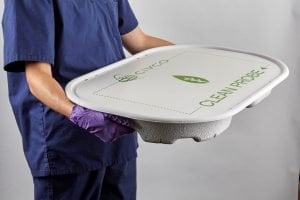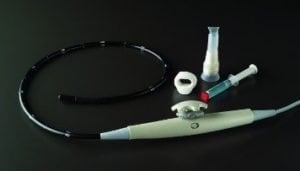TEE Probe High-Level Disinfection

The process of performing high-level disinfection on ultrasound probes - both transesophageal (TEE) and endocavity transducers - possesses unique challenges, and it can often be hard to know exactly what steps to take along the way. Below are some of the key tips to remember when disinfecting transducers to ensure a proper, thorough cleaning for your probes.
 1. ULTRASOUND PROBES ARE DELICATE (AND EXPENSIVE)
1. ULTRASOUND PROBES ARE DELICATE (AND EXPENSIVE)
The TEE transducer's long insertion tube can be difficult to disinfect because of its length, and is thus vulnerable to damage. Even a small bump to the distal tip can damage the probe. You should take extra caution when handling the probe - whether it's rinsing, transporting, or storing.
Frequent daily transport of ultrasound probes can pose significant challenges for your department when it comes to both infection control and probe safety.
 For TEE probes, CIVCO's TEE Probe Transport Tray can help you to maintain compliance with national transport standards and OEM guidelines, while also providing secure storage for your delicate probes during transportation, reducing the risk of damage to the TEE probe and negating potential cross-contamination.
For TEE probes, CIVCO's TEE Probe Transport Tray can help you to maintain compliance with national transport standards and OEM guidelines, while also providing secure storage for your delicate probes during transportation, reducing the risk of damage to the TEE probe and negating potential cross-contamination.
2. PROBE COVERS ARE RECOMMENDED
 Per FDA guidance documents, a probe cover or sheath is required every time a probe is used in a semi-critical application. Many leading ultrasound system manufacturers recommend the use of a probe cover for their ultrasound transducers. Philips recommends a sterile sheath in addition to patient bite blocks.
Per FDA guidance documents, a probe cover or sheath is required every time a probe is used in a semi-critical application. Many leading ultrasound system manufacturers recommend the use of a probe cover for their ultrasound transducers. Philips recommends a sterile sheath in addition to patient bite blocks.
3. PRECISE SOAKING TIME PROTECTS THE PROBE
When disinfecting your TEE probes using a manual disinfection process, it's imperative to soak the probe only for the time advised by the high-level disinfectant solution manufacturer. Oversoaking the probe can be corrosive and possibly damage the probe.
4. ENSURE ADEQUATE RINSING
Be sure to rinse the TEE probe properly after soaking. Some disinfectants are more difficult to rinse off the probe. For example, when using an aldehyde-based disinfectant, you need to rinse the TEE probe thoroughly, e.g. 3 separate large volume rinses.
5. AUTOMATED DISINFECTION IS A SIMPLIFIED OPTION TO MANUAL DISINFECTION
Automated high-level disinfection cleans the TEE probe with greater efficiency than a manual disinfection process. CIVCO's ASTRA TEE® (for TEE probes) and ASTRA VR (for endocavity probes) allows disinfection of two probes at once, automates the soak and rinsing steps, and provides a fully automated disinfection log for streamlined compliance.
 6. CLEANING THE TEE PROBE AIDS THE DISINFECTION PROCESS
6. CLEANING THE TEE PROBE AIDS THE DISINFECTION PROCESS
Whether you utilize an automated or manual process to disinfect your TEE probes, you must clean your devices properly. First, clean the probe at the bedside and then clean the probe using an enzymatic detergent or according to your probe manufacturer's Instructions for Use.
7. ELECTRICAL LEAK TESTING OF TEE PROBES IS REQUIRED
As of December 31, 2015, the Intersocietal Accreditation Committee (IAC) began requiring leak testing of TEE transducers between every procedure. A damaged probe can lead to a black mouth (chemical burning due to improperly rinsed disinfectant) or an electrical shock to the patient (with the probe only inches from the patient's heart).
8. PROPER STORAGE IS THE FINAL STEP
The Joint Commission (TJC) and probe manufacturers recommend storing probes in a manner to protect them from damage and contamination. In addition, TJC recommends that you hang probes vertically in a cabinet and store them in a clean, dry environment. Tip guards also help protect the probe's distal tip between uses.







